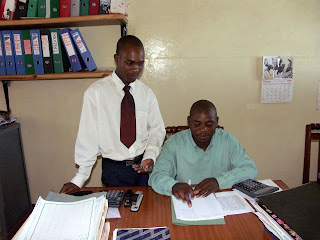Warning: the photos in this post may not be suitable for viewing at dinner time. Over the last seven weeks, I have seen quite a few things at the hospital that I am sure I probably won’t see in Australia:
Malaria, while always on the back of a clinician’s mind in Zambia, is hardly ever one of the differential diagnoses in Australia unless the patient has traveled to endemic regions like Africa or Southeast Asia. In the last seven weeks, I probably have seen and treated more patients with malaria than I will for the rest of my career in Australia.
Malnutrition, with severe cases in the forms of kwashiorkor and marasmus and milder cases presenting as anemia, is so prevalent, the hospital has a special kitchen to cook food for feeding those admitted for it. Anemia is so common, the hospital guideline is to transfuse those whose hemoglobin has dropped to 5 g/dL or lower (that’s VERY anemic); otherwise the bloodbank would run out of blood in no time.
TB is also quite a common illness in this part of Zambia. The hospital has a special isolation ward for it. While the TB ward has only had a few patients in the last couple of months, many patients who come to the hospital with respiratory complaints are tested for it.
HIV is a big killer. We send patients, both inpatients and outpatients, for HIV testing as often as GPs in Australia send overweight patients to test for blood sugar level. Not only are pregnant women who come for antenatal check ups tested, the hospital sends outreach teams to test pregnant women in outlying villages. I have seen patients come in for the first time with full-blown AIDS barely clinging on to life; on the other hand, at the ART clinic, I have seen many asymptomatic patients come in to get their medication to keep their infection in check and their CD4 count up.

These two patients presented for the first time with fungal infection of their skin. Both were then diagnosed HIV positive while in hospital. Their fungal infections were successfully treated and they were started on ART.
But none of these is as dramatic as some of the wounds that come through the hospital. As usual, all of these patients presented only when their pain became excruciating or when parts of their limb fell off.
~~~~~~~~~~

This patient fell off a bicycle and got a puncture wound on his ankle. He thought nothing of it at the time. But three weeks later, as his leg got more and more swollen, became more and more painful, he finally decided to come in. When I examined him, his leg was swollen to twice the size of his other leg. Barely a slight touch would send him through the roof. The infection had spread to mid thigh but, lucky for him, spared the bones. We pumped him full of antibiotics for a couple of weeks, debrided the wound, and he eventually left the hospital smiling.
~~~~~~~~~~

These are two patients with very similar injuries. One said her finger just started to swell up on its own. The other patient suffered a snake bite to his finger. In both cases, the wound got infected and eventually the bones were exposed while the rest of the finger became swollen and painful. Both of them got their affected finger amputated all the way down to the metacarpophalangeal joint.
~~~~~~~~~~

This patient was bitten by a snake on his foot. Fortunately, the snakes around here are rarely poisonous. Unfortunately, he, like so many others in this area, has a very poor concept of hygiene. The bite became infected; the skin started to erode away. He just kept it wrapped in a dirty rag until the foot became too painful to walk on. When he came in to hospital, flies were circling around the wound. We debrided the wound, kept it in wet dressing, and gave him antibiotics. Eventually the infection settled, granulation tissues formed, and he went home happy. Too bad I didn’t get a picture of his foot the day he went home; it was healing beautifully.
~~~~~~~~~~

This farmer dropped a hoe on his foot and made a very small break in the skin. But similarly, he didn’t keep the wound clean. He hobbled in to hospital with the foot swollen with a huge blister. When the blister broke, the skin generally sloughed off, leaving the strip of necrotic skin in the middle. I ordered an x-ray and made sure the infection had not spread to the bones. I then debrided the wound, scrubbed it clean and washed it with copious amount of saline.

And this is what it looked like two days later. Isn’t it beautiful?
~~~~~~~~~~

This series of photos is the most impressive wound of them all. This patient’s wound started as a scratch from a tree branch at the front of his leg. Again, lack of hygiene = massively infected wound. Treatment was the same: wound debridement and wet dressing.

Despite the antibiotics we gave him, his infection started to advance up towards his knee and the back of his leg. A week later, the skin on the newly-infected part started to melt off. Notice the anterior and lower half of his leg was already starting to heal. The patient was again in agony; it took pethidine and diazepam to calm him down. We changed around his antibiotic regime a bit and went for a second debridement.

Two days after the second debridement and his leg was looking good! The infection has stopped advancing. The leg may look like raw hamburger, but it’s a good thing – it’s getting good blood supplies, which promotes healing. It may not look it, but the patient was now in minimal pain and only required Panadol (same as Tylenol).

Today, his leg is looking amazing. The granulation tissue at the anterior part of his leg is already epithelializing. The rest is on its way. The infection is gone; the patient is happy, He should be able to go home in a week.
~~~~~~~~~~

This woman in her sixties came in like this. Upon getting her history, I learned that her problem started as a cut on her toe. It quickly became gangrenous and fell off. She didn’t want to go to the hospital at that point. The gangrene spread to the other toes and they fell off too. Still, no hospital. After the entire foot dropped off, that was when she decided to take a trip to the hospital – carried by a relative on the back of a bike! The nitrogenous smell emitted from the leg was unmistakably that of gas gangrene – it definitely made a permanent imprint on my olfactory memory. Treatment was amputation of that leg before the gangrene spread up. Unfortunately, she also had heart failure, which meant she wouldn’t be able to tolerate general anesthesia. To stabilize her heart failure would take time – time she could ill afford. As we lack the expertise in handling this type of situation, we referred her to the provincial hospital.
~~~~~~~~~~

Doesn’t this picture just make you go “Awwwww”? This girl fell from a tree and broke one of her legs. Standard treatment here is not to refer her to an orthopedic surgeon, because they don’t exist in this part of the country. The old-school method is traction – long abandoned by hospitals in developed countries. Here, it’s still the standard treatment. So she was strung up to a pair of railings over the bed for three weeks. The other leg was on traction simply for balance. She didn’t mind at all; when I saw her, she was just happily playing in that position. This picture was taken just before the strings were cut and she was sent home.
Now, that’s something you don’t see everyday!


















































